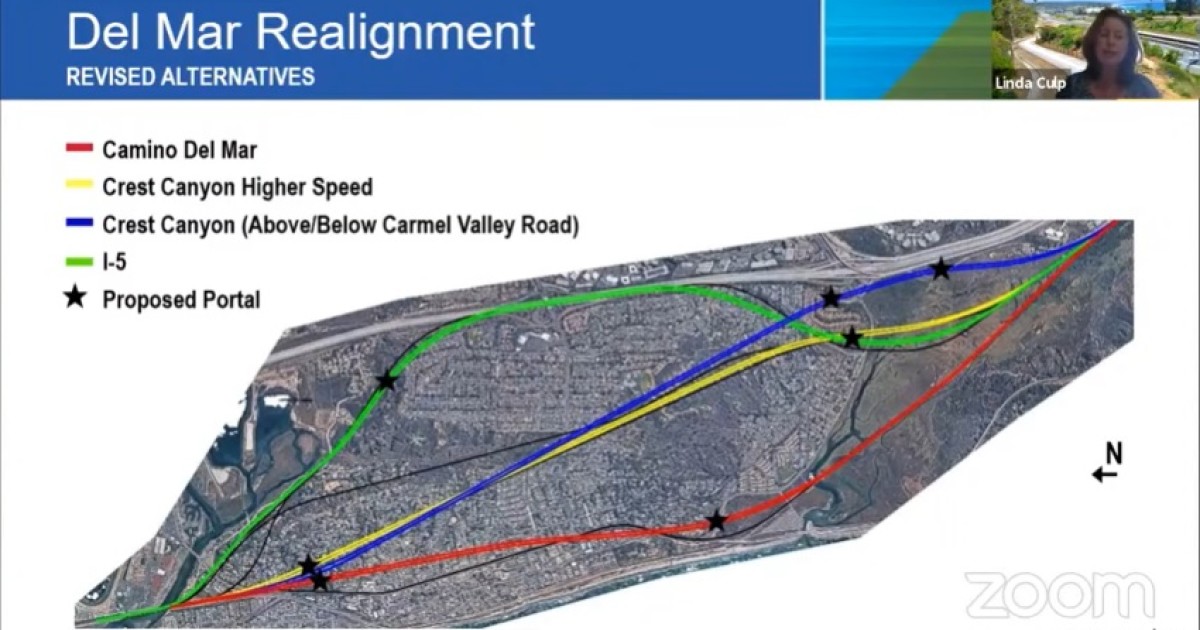Recent studies show a route through Crest Canyon is the highest rated of five potential choices for a railroad tunnel that would take the railroad tracks off the eroding coastal bluffs in Del Mar.
Other possible underground routes include one along Interstate 5, one beneath the street of Camino Del Mar though the city of Del Mar, and two more through Crest Canyon, according to a conceptual analysis by the San Diego Association of Governments and its consultants.
SANDAG, North County Transit District and other local agencies have talked for years about moving the tracks off the bluffs, but only recently have the agencies received grant money for the preliminary studies required. Construction alone is expected to cost $3 billion or more.
“There was some sticker shock back when these discussions were first held,” NCTD board Chairman Tony Kranz said when the update was presented at last week’s board meeting.
“Recently, we’ve been seeing (more) of the bluff collapses, and we recognize now, everybody in the region as well as the state, that this has got to have a higher sense of urgency,” said Kranz, an Encinitas City Council member.
“NCTD has been working pretty hard to move people in the direction of stabilizing the bluff in order to buy time to do this analysis, and then raise the money to actually construct a project,” he said.
The conceptual analysis is expected to be completed by next April. Planning, environmental studies, engineering and design are likely to take at least five years. If money becomes available, construction could be completed in an additional five years.
“We’ve been at this about eight or nine months now,” said Linda Culp, a principal planner for SANDAG, in her presentation Thursday to the NCTD board of directors.
Three of the five initial proposed tunnel alignments go through Crest Canyon, a mostly undeveloped area about halfway between I-5 and the coast. The preferred route is a total of 4.8 miles including a 2.5-mile tunnel, slightly longer than the other canyon routes, but allows the fastest travel times and scored the highest overall rating based on 11 weighted factors.
The route along I-5 proved to be the longest, the costliest, with the slowest travel times, and as a result it is unlikely to be studied further, Culp said. Instead, the remaining conceptual studies will focus on the so-called “higher speed” Crest Canyon tunnel and the Camino Del Mar alignment.
Either alignment would include an “approach structure,” probably a bridge or a trestle, as long as a mile or more to elevate the tracks to the tunnel’s entry or exit.
Enhanced safety, reduced travel times and increased capacity are the goals of the realignment, Culp said.
Presently, the top speeds on the San Diego segment are 90 mph for passenger trains and 60 mph for freight trains. The new Siemens diesel locomotives purchased by NCTD are capable of up to 125 mph, but their speed is limited by the condition of the tracks and equipment.
Realignment of the tracks would allow top speeds of 110 mph, Culp said.
Moving the railroad off the bluffs also would allow room to build a second set of tracks to eliminate the bottleneck at Del Mar. About two-thirds of the 60-mile coastal rail segment in San Diego County has been double-tracked, which increases capacity by allowing trains to pass each other.
Also part of the study underway is realignment of an inland section of track known as “Miramar hill,” just south of Sorrento Valley, where the topography limits train speeds. That proposal includes a tunnel of about 2.5 miles depending on the alignment chosen.
“This is the slowest segment … between San Diego and Los Angeles,” Culp said.
Trains now take 31 minutes to go between Solana Beach and Old Town, and the proposed Miramar realignment could reduce that to about 20 minutes.
Together the Del Mar and Miramar tunnels would reduce the travel time between Oceanside and San Diego, including stops at all the stations on the route, from the present 56 minutes to 39 minutes.
Zero-emission locomotives, powered by electric batteries or hydrogen, will be required in the future and are included in the SANDAG analysis. They can reach top speeds more quickly than diesel engines and will further reduce travel times.
Also part of the conceptual studies underway are a proposed platform that would allow trains to stop for special events at the Del Mar Fairgrounds and platforms for stops at the UTC shopping mall and the San Diego airport.

